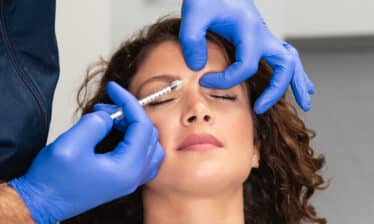One common sign of aging is loss of volume in the face. Over time, fat and collagen deposits diminish, leaving skin looking looser and contributing to the appearance of wrinkles. After a certain point, topical treatments can’t make up for the changes that happen under the skin.
There is a wide array of treatments for wrinkles and slack skin on the face. Dermal fillers are a temporary treatment that adds volume but needs to be refreshed periodically. Surgical facelifts can correct the signs of aging permanently, but they come with all the risks of major surgery.
Some people turn to facial fat grafting for a treatment that lasts longer than fillers but has fewer risks than surgery. With this procedure, your doctor injects fat from another site on your body into your face to address loose skin and wrinkles.
What Is Facial Fat Grafting?
Facial fat grafting is fat transfer to your face from another part of your body. It can treat deep wrinkles, add volume to the cheeks or lips, or improve the look of scars.
Facial fat grafting is a two-part procedure. First, a plastic surgeon removes fat from an area of your body, such as the thighs or buttocks. After cleaning and preparing the fat cells, your doctor injects the fat into the desired area.1
Benefits of Facial Fat Grafting
Unlike dermal fillers like Restalyne or Juvederm, fat injections are permanent.2 The transferred fat cells remain in place and don’t get reabsorbed the way fillers do.3 Fat grafting can create a more natural-looking result than dermal fillers, and there is no risk of reactions since the fat is from your own body.4
What To Expect When You Get Facial Fat Grafting
Many facial fat grafting procedures can be done while you are awake. However, some doctors prefer to use general anesthesia for fat grafting. You should discuss that with your doctor before the procedure.5
The first step will be harvesting fat from the donor site on your body, such as the thighs or buttocks.6 The doctor will use a special needle called a cannula to extract fat. They will then clean and prepare it for transfer.
If you are awake, you will get a local anesthetic to numb the area being treated. Your doctor will carefully place the harvested fat into the selected parts of your face. The length of the procedure depends on how large the treatment area is.
After the procedure, you may have some discomfort where the fat was harvested and where it was grafted. You may have pain, swelling, and bruising.7 Your doctor will give you instructions about your post-procedure care. You may need to rest for a few days and avoid strenuous activity. It may take several weeks for swelling to subside enough to view the results.8
How To Learn More
To learn more about your options for facial fillers, My Filler Treatment has comprehensive articles on the most current treatments. If you are interested in facial fat grafting, contact a board-certified plastic surgeon to learn more.
SOURCES:
- Stanford Medicine: “Facial Fat Grafting.”
- Cleveland Clinic: “Fat Transfer.”
- Cleveland Clinic: “Fat Transfer.”
- Cleveland Clinic: “Fat Transfer.”
- Cleveland Clinic: “Fat Transfer.”
- Cleveland Clinic: “Fat Transfer.”
- MedStar Health: “Facial Fat Grafting.”
- MedStar Health: “Facial Fat Grafting.”






